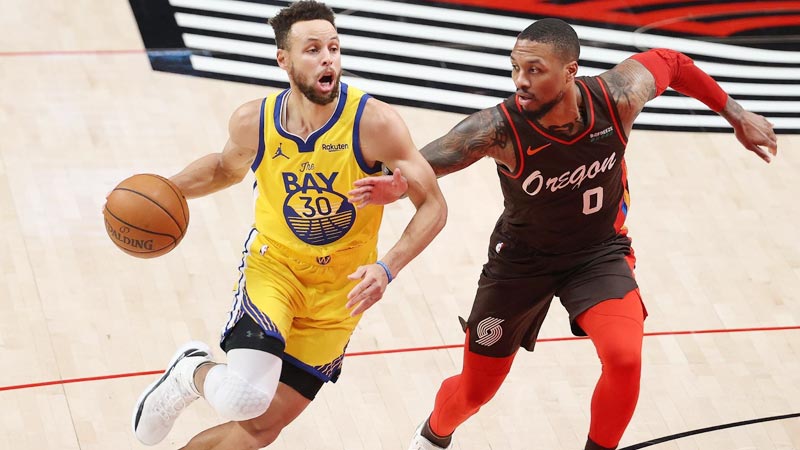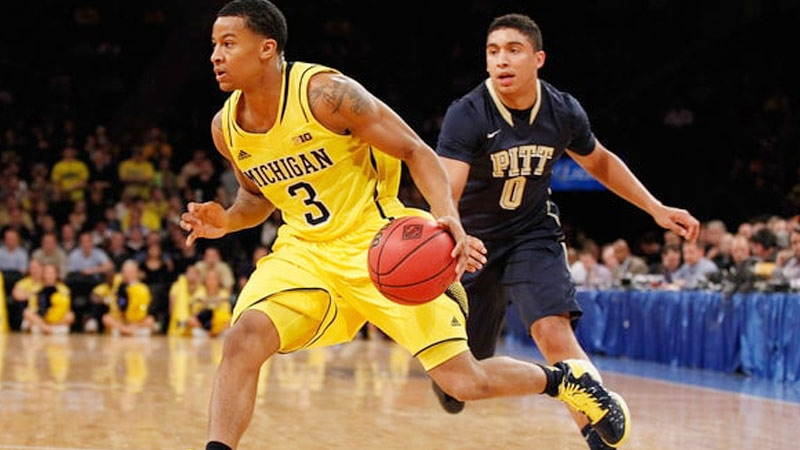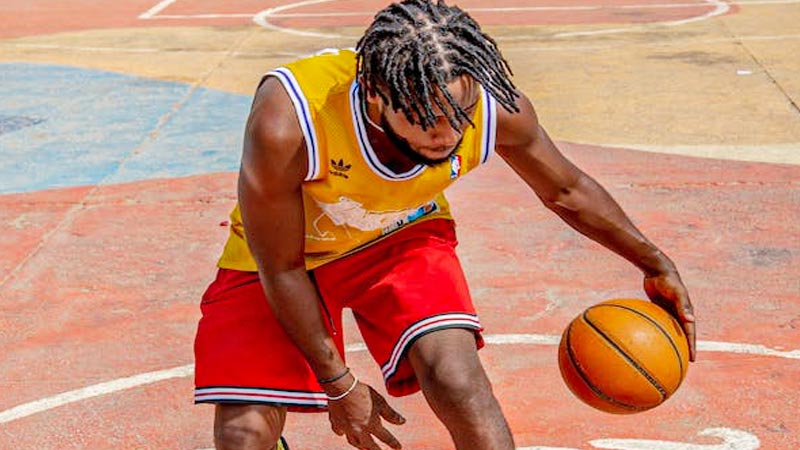Guarding in basketball is a vital skill that every player, regardless of their position, must possess. An effective defense can disrupt the opponent’s offense, create turnovers, and contribute to the overall success of a team.
In this comprehensive guide, we will delve into the art of guarding in basketball, exploring various techniques, strategies, and tips to elevate your defensive game.
Whether you’re a beginner learning the basics or an experienced player looking to refine your skills, this article will provide you with the knowledge and tools to become a formidable defender on the court. So, stay focused.
What Is Guard in Basketball?
In basketball, the term “guard” refers to players who primarily focus on defending the opposing team’s guards and perimeter players.
Guards play a crucial role in the team’s defensive strategy, as they are responsible for applying pressure, denying passes, contesting shots, and disrupting the opponent’s offensive flow.
One of the primary responsibilities of guards is to defend their assigned player, usually the opposing team’s point guard or shooting guard.
Guards must possess the agility, lateral quickness, and defensive instincts to effectively stay in front of their assigned player and limit their offensive impact.
What Are the Types of Basketball Guards?

Source: sportingnews.com
Basketball guards play a crucial role in a team’s success, and their playing style and skill set can vary greatly. Guards are typically responsible for ball handling, setting up plays, scoring, and defending the perimeter.
However, within the realm of guards, there are various types, each with its own unique characteristics and responsibilities. Here are some different types of basketball guards:
Point Guard
The point guard is often considered the floor general, responsible for directing the team’s offense. They are usually the primary ball handler and playmakers, setting up plays, distributing the ball, and orchestrating the team’s offense.
Point guards possess excellent court vision, passing skills, and decision-making abilities. They are also expected to be solid defenders and capable of initiating fast breaks.
Shooting Guard
The shooting guard, also known as the off-guard or two-guard, typically focuses on scoring. They are often one of the team’s primary scoring options, whether through perimeter shooting, mid-range jumpers, or attacking the basket.
Shooting guards are skilled at moving without the ball, coming off screens, and creating their own shots. They are expected to have good shooting accuracy and be capable of providing a scoring punch.
Combo Guard
A combo guard is a player who possesses the qualities of both a point guard and a shooting guard. They have the versatility to play and contribute in both positions. Combo guards can handle the ball, initiate the offense, and create opportunities for teammates like point guards.
Simultaneously, they can also score effectively, both from the outside and by driving to the basket, like shooting guards. Combo guards provide flexibility to a team’s lineup and can adapt to different game situations.
Defensive Specialist
While not limited to the guard position, some players specialize in defense and are often referred to as defensive specialists. These guards prioritize shutting down the opponent’s best perimeter scorer and disrupting passing lanes.
They possess excellent lateral quickness, agility, and defensive instincts. While their offensive contributions may be limited, defensive specialists provide valuable contributions by neutralizing the opposing team’s scoring threats.
Scoring Point Guard
While traditional point guards focus on distributing and setting up teammates, scoring point guards have a more aggressive scoring mentality.
They are adept at creating their own shot, attacking the basket, and scoring in various ways. Scoring point guards often possess exceptional dribbling skills, a quick first step, and the ability to finish at the rim. They combine scoring prowess with the ability to set up teammates, making them potent offensive weapons.
Playmaking Guard
Playmaking guards excel at creating opportunities for their teammates. They have excellent passing skills, court vision, and a high basketball IQ.
Playmaking guards often look to involve their teammates and make the right play, whether it’s a pinpoint pass, an alley-oop, or a well-timed kick-out to an open shooter. They focus on facilitating the offense and elevating the overall performance of the team.
What Are the Different Techniques of Basketball Guards?

Source: basketballhq.com
To become a proficient guard in basketball, players must possess a repertoire of defensive techniques that allow them to effectively disrupt the opponent’s offense.
These techniques encompass both on-ball and off-ball defense, as well as the fundamentals of a solid defensive stance and the importance of communication. Let’s explore these techniques in detail:
On-Ball Defense
On-ball defense is a fundamental technique that involves guarding the offensive player closely. It requires proper footwork, active hands, and body positioning to impede the progress of the opponent and prevent easy scoring opportunities.
Successful on-ball defender stays in front of their assignment, moves their feet quickly, and uses their hands to contest shots or disrupt dribbles without fouling.
Off-Ball Defense
Off-ball defense focuses on denying passes, intercepting the ball, and maintaining positional awareness. As an off-ball defender, you need to anticipate the movements of both the player you’re guarding and the ball.
By denying passes and being in the right position, you can disrupt the opponent’s offensive strategies and contribute to steals and turnovers.
Defensive Stance
The defensive stance is the foundation of guarding. It involves bending the knees, keeping the feet shoulder-width apart, and maintaining balance.
By assuming a low and wide defensive stance, players can move quickly in any direction, react to offensive moves, and stay balanced to guard effectively.
Closeouts
A closeout is a technique used by defenders to quickly close the distance to an offensive player. It is employed to contest their shot or prevent them from driving to the basket.
Closeouts require proper timing, agility, and the ability to anticipate the offensive player’s movements. A defender must close the gap with urgency, maintain balance, and use active hands to challenge shots or deter drives.
Communication
Effective communication is vital in guarding, as it allows defenders to coordinate switches, rotations, and defensive assignments.
Clear and concise communication among teammates helps prevent defensive breakdowns, ensures everyone is on the same page, and fosters a cohesive defensive effort.
Communicating screens, switches, and helping defense can significantly enhance a team’s defensive performance.
How To Guard In Basketball?
Mastering the art of guarding in basketball is essential for any player looking to excel defensively. An effective defense can disrupt the opponent’s offense and make a significant impact on the outcome of the game.
In this section, we will explore key strategies and techniques to elevate your guarding skills and become a formidable defender on the court.
Study Your Opponent
Before stepping onto the court, take the time to study your opponent. Analyze their tendencies, strengths, and weaknesses. Observe their preferred moves, shooting range, and driving tendencies.
By familiarizing yourself with their game, you can anticipate their actions, position yourself accordingly, and make it more challenging for them to score.
Focus on Footwork
Quick and agile footwork is crucial for effective guarding. Practice defensive slides, pivots, and shuffles to maintain proper positioning and stay in front of your opponent.
Solid footwork allows you to mirror your opponent’s movements, stay balanced, and react swiftly to changes in direction. It also enables you to close out on shooters and contest shots effectively.
Develop Active Hands
Active hands can disrupt passing lanes, deflect passes, and block shots. Work on improving your hand-eye coordination, timing, and anticipation to effectively use your hands as defensive tools.
Keep your hands up and active, ready to contest shots or make a steal when the opportunity arises. By having active hands, you can make it difficult for your opponent to pass or shoot comfortably.
Anticipate and React
Successful guarding requires the ability to anticipate offensive moves and react quickly. Pay close attention to your opponent’s body language, study their eyes for cues, and learn to read their movements.
By anticipating their actions, you can make split-second decisions to cut off their options, disrupt their rhythm, and force turnovers. Quick reactions allow you to stay one step ahead of your opponent and make impactful defensive plays.
Stay Engaged and Hustle
Defense is not only about physical skills but also mental focus and effort. Stay engaged throughout the game, constantly communicating with your teammates, and maintaining a high level of intensity.
Hustle for loose balls, dive for rebounds, and give relentless effort on every defensive possession. A committed and engaged defender can disrupt the opponent’s flow, create turnovers, and energize the entire team.
Additional Tips for a Better Guard in Basketball
Incorporate these additional tips into your training regimen, and consistently work on refining your skills.
Improve your conditioning and agility through specific drills
To be an effective guard, you need to have the endurance and agility to keep up with the fast-paced nature of the game. Incorporate cardio exercises such as sprints, interval training, and jump rope into your training routine.
Additionally, work on agility drills such as ladder drills, cone drills, and lateral movements to improve your quickness and change of direction.
Work on your lateral quickness
Lateral quickness is crucial for guards as it allows you to stay in front of your opponent and prevent them from penetrating the defense.
Incorporate lateral movement drills, such as defensive slides and shuffle drills, into your training.
Focus on maintaining a low defensive stance, keeping your feet active, and using quick, explosive movements to stay connected to your opponent.
Learn to use screens effectively
How to utilize screens is essential for guards. On offense, learn how to navigate through screens to create scoring opportunities or open passing lanes for your teammates.
On defense, learn how to fight through screens, communicate switches, and recover quickly to stay in front of your assigned player.
Work on your footwork, communication, and awareness to maximize the effectiveness of screens in both offensive and defensive situations.
Develop your basketball IQ
Basketball IQ refers to your understanding of the game and the ability to make smart decisions on the court. As a guard, it is crucial to develop a high basketball IQ.
Study offensive sets, learn different plays, and understand how teams attack defenses. This knowledge will help you anticipate plays, make timely rotations, and disrupt the opponent’s offensive flow.
Watch the game film of elite defenders
One of the best ways to improve as a guard is to study and learn from elite defenders. Watch game footage of renowned defensive players in your position and analyze their techniques, positioning, and decision-making.
Observe how they use their hands, footwork, and body positioning to disrupt the offense. By studying and emulating their strategies, you can enhance your own defensive skills and become a more impactful guard on the court.
FAQs
How can I improve my defensive stance?
To improve your defensive stance, focus on keeping your knees bent, staying low, maintaining a wide base, and keeping your weight balanced.
Practice defensive slides and drills that emphasize maintaining a strong defensive stance.
How can I guard against a quicker opponent?
When guarding a quicker opponent, focus on using your body and positioning to cut off their driving lanes.
Anticipate their moves, use your hands to disrupt their dribble, and rely on your defensive stance and footwork to stay in front of them.
How can I improve my help defense?
To improve your help defense, develop your court awareness and communication skills.
Anticipate when your teammates need help, rotate quickly to the appropriate position, and communicate with your teammates to ensure seamless defensive coverage.
How can I defend against a skilled shooter?
When guarding a skilled shooter, it’s crucial to close out with urgency, contest every shot, and stay disciplined in your defensive positioning.
Anticipate their shooting tendencies, challenge their shots without fouling, and use your length and agility to bother their release.
How can I defend against taller opponents?
When guarding taller opponents, focus on using your quickness, positioning, and active hands to disrupt their shots and passes.
Deny entry passes into the post, work to front the post player, and use your leverage to prevent easy scoring opportunities.
Bottom Line
Becoming a proficient defender in basketball requires a combination of skills, techniques, and a relentless mindset.
By understanding the different types of guards, mastering defensive techniques, and implementing strategic approaches, you can elevate your defensive game.
With practice, focus, and a commitment to improvement, you can make a significant impact on the court and become a valuable asset to your team.
Embrace the challenge of guarding, and let your defensive prowess shine on the basketball court. Best of luck.







